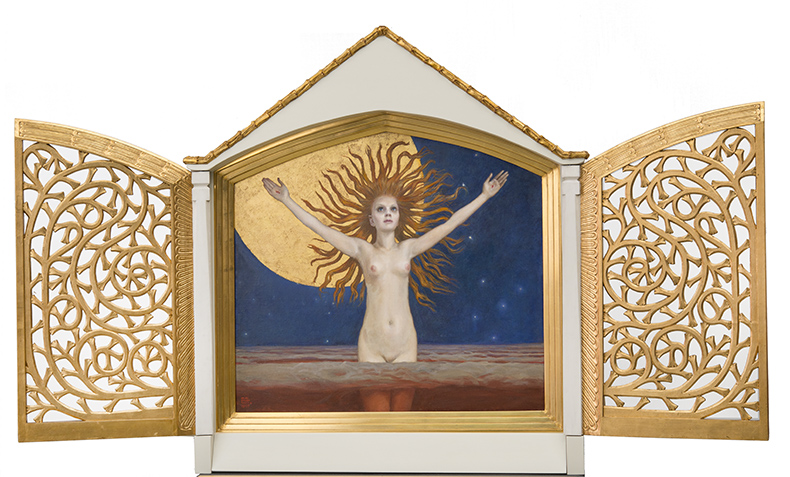‘Do you feel how vast white and icy expanses can fascinate and attract?’ Akseli Gallen-Kallela wrote in 1897. As we see them through his eyes in a series of paintings from the early 20th century, it would be impossible not to. Here, snow is far from a neutral presence. It fascinates precisely because, as in life, it presents as a vacant expanse, but one in which we can see each rising knoll or collapsing deluge. Rockface dappled with lichen-covered craters pokes out from beneath a dense yet yielding blankness in Snow-covered cliffs at Kalela (1901), but we never lose sight of the rock’s surface. Deep in the snowy forests that Gallen-Kallela traversed with a group of hunters in 1906 and recorded in his The Lair of the Lynx of the same year, dazzling sunlight and bright blue shadows are interlaced across a frosty surface to mesmeric effect.
Gallen-Kallela’s ability to render a modestly sublime yet knowable landscape is evident throughout a new exhibition at the Musée Jacquemart-André in Paris. The universal appeal of the works won the artist international acclaim and the respect of his more avant-garde peers, but they also have an intimate specificity. Gallen-Kallela was an anti-authoritarian who ardently supported Finnish independence (the country was a grand duchy of the Russian empire between 1809 and 1917). One of the more unusual works on display, Rouse Thyself Finland! (1896), is a piece of stained glass in which a white rose representing Finland rises over Lake Keitele.
Paysage sauvage de lac (1892), Akseli Gallen-Kallela. Fondation Gösta Serlachius, Mänttä. Photo: The Gösta Serlachius Fine Arts Foundation, Teemu Källi

He returned to this landscape even as he studied, during the 1880s, at the Academie Julien and atelier of Fernand Cormon in Paris, where he fell in with a circle of Nordic painters. Though he produced pleasant scenes of bars and boulevards, these hardly distracted him. ‘On account of my homesickness in so-called great civilised countries – Germany, France, England, and Italy – I have not been able to depict their landscapes or draw a single line to visualise the life of their people. I could not even if I sometimes wanted to,’ he later remarked. Instead, each summer he returned to Finland, where he painted the sunset from the shores of Lake Jamajärvi.
Then known as Axel Gallen, he quickly made a name for himself with these paintings, debuting at the Salon des Artistes in 1886 and winning a medal at the Exposition Universelle in 1889. By 1890, he had married and spent his honeymoon in East Karelia, near the border, where he portrayed his rural neighbours – seemingly as representatives of an authentic Finnish people. Just a few generations earlier, they had shared their spoken folklore with the philologist Elias Lönnrot, to be compiled in his epic Kalevala (1835), a touchstone for Finnish identity.
Mary tissant à Kalela (1897), Akseli Gallen-Kallela. Photo: Jukka Paavola/The Gallen-Kallela Museum

Soon after this encounter, Gallen-Kallela, who had studied Finnish traditional log architecture, sought out a peninsula at Ruovesi to build Kalela, his family homestead and studio. A general interest in landscape evolved into a more personal portrayal of his own private dwelling – many works after this time are vistas from his porch – occasionally featuring him and his family rowing or skiing outside.
The exhibition gives ample space to lesser-known strands of Gallen-Kallela’s work, such as his mixed media designs, among them stylised and verdant murals showing the seasons of life for a mausoleum. Flame, an almost abstract design, is here seen on a wall-hanging, one of several furnishings and furniture produced for the Finnish Pavilion at the Exposition Universelle in 1900. Elsewhere, small scale engravings, made in wake of his young daughter’s death in 1895, explore darker themes. Inspiration, a particularly devastating work from 1896, shows Gallen-Kallela huddled by the hearth in the throes of grief.
Ad Astra (1907), Akseli Gallen-Kallela. Fondation Signe et Ane Gyllenberg, Helsinki

A suite of rooms dedicated to Gallen-Kallela’s interest in mythology, spirituality and symbolism are particularly striking in a relatively pokey gallery space. Esoteric works such as River of the Dead (1893), in which a river flows through infinite space, reflect the artist’s participation in seances and study of astronomy. Ad Astra (1907), an ambiguous painting in an intricate gold frame, depicts a young woman with arms outstretched and visible stigmata. It is presented in the manner of an altarpiece in an otherwise darkened, chapel-like room.
Despite tackling a great range of subject matter, Gallen-Kallela is still regarded primarily as a landscape painter. On this occasion, The Aino Triptych returns to Paris where it was painted in the 1880s. It was his first subject from the Kalevala, a book he read in secret as a child. The work stages Finnish legend within the country’s gently majestic landscape and, adding a personal touch, the character of Aino is modelled for by his wife. Combining the mythic with the intimate and everyday, Gallen-Kallela produced a contemporary cultural heritage for Finland. Fighting on the side of the ‘Whites’ alongside his son Jorma in the Civil War in 1918, he would live to see his country become a sovereign nation.
‘Gallen-Kallela: Myths and Nature’ is at the Musée Jacquemart-André, Paris, until 25 July.



